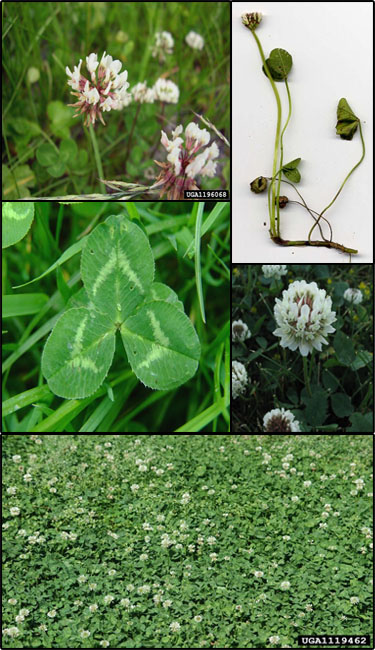White clover (Trifolium repens)
 Synonyms: Trifolium repens L. var. atropurpureum
Synonyms: Trifolium repens L. var. atropurpureumCommon Names: Dutch clover, ladino clover
Description: Used as a companion plant and livestock fodder. Also used for its medicinal purposes to treat fevers.
Habit: Erect or creeping; perennial forb; rooting from the stems; grows up to 6 in tall.
Leaves: Leaflets are oval or circular, serrated, whitish markings on the middle of upper surface.
Stems: Smooth with trifoliate leaves.
Flowers: 3/4 in across are produced on long naked stalks (peduncles) that are unbranched and hairless, 20-50 flowers, globular in shape, narrowly tubular, green calyx with 5 narrow teeth, 5 petals that are white or pinkish white.
Fruit and seeds: Flowers turn brown and replaced by seed pods, contains only a few seeds, flat, round or slightly heart-shaped, various colors.
Habitat: Native to Europe. Found in pastures, fields, grassy meadows, lawns, parks, mowed areas along roadsides, paths through woodlands, and waste areas.
Reproduction: By seed or vegetatively by rhizomes and stolons.
Similar species: Alsike clover (Trifolium hybridum); native Buffalo clover (Trifolium reflexum) and native Running buffalo clover (Trifolium stoloniferum).
Monitoring and rapid response: Effectively controlled using any of several readily available general use herbicides. Credits: The information provided in this factsheet was gathered from Illinoiswildflowers.info, the Robert W. Freckmann Herbarium and the USDA PLANTS Database.
Individual species images that appear with a number in a black box are courtesy of the Bugwood.org network (http://www.invasive.org).Individual photo author credits may not be included due to the small display size of the images and subsequent difficulty of reading the provided text. All other images appear courtesy of Google (http://images.google.com).
